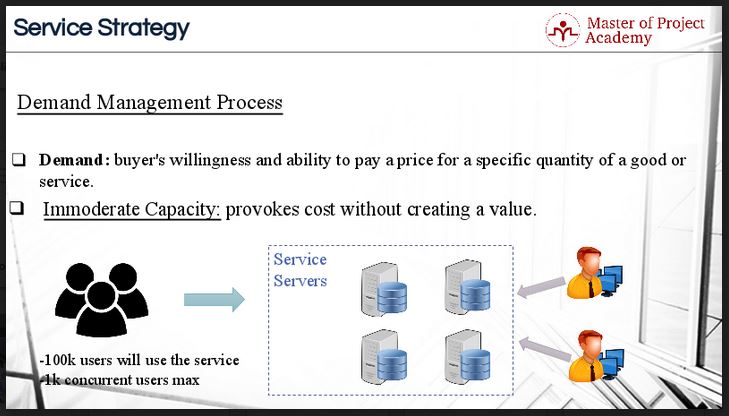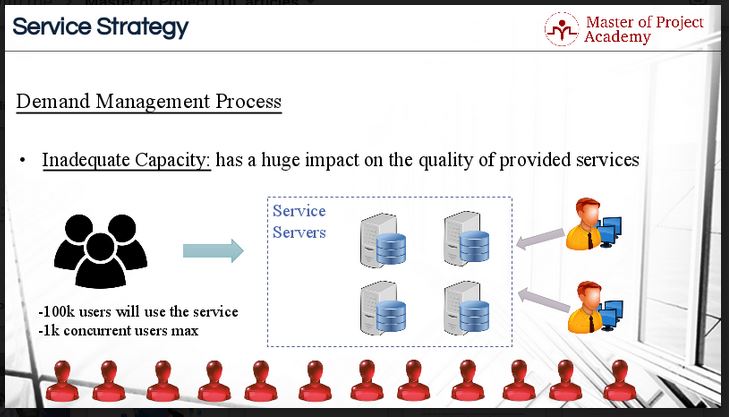ITIL Service management and ITIL demand management go hand in hand. Proper IT service management as discussed in the ITIL course, can’t be performed if ITIL demand management is not taken into account. Insufficient ITIL demand management can affect the quality of the service, create a barrier for new customers to use your service or it can lead to unnecessary capital expenditure and overhead costs. Service owners who are responsible for a specific service should be aware that ITIL demand management is a critical factor as part of the IT service management process, especially in the ITIL Service Strategy and ITIL Continual Service Improvement stages of the service lifecycle.
In this article, we are going to explore the two sides of ITIL demand management, explain how to perform an ideal ITIL demand management and also give some examples of ITIL demand management.
ITIL Demand Management: Definition
Before diving into mechanics of ITIL demand management process, it is better to give the dictionary definition of the demand.
Demand is a buyer’s willingness and ability to pay a price for a specific quantity of a good or service.
As explained in ITIL foundation certification training, demand refers to how much (quantity) of a product or service is desired by buyers at various prices. The quantity demanded is the amount of a product people are willing to buy at a certain price; the relationship between price and quantity demanded is known as the demand. The term demand signifies the ability or the willingness to buy a particular commodity at a given point of time, ceteris paribus i.e. with all other conditions remaining the same. Utility preferences and choices underlying demand can be represented as functions of cost, benefit, odds and other variables.
IT service providers must apply ITIL demand management of its services properly. In order to do this, they must understand that there are two sides of the coin in ITIL demand management. Both sides of the coin have negative consequences for the company and these two must be carefully balanced for the IT service to create optimal revenue.
ITIL Demand Management: Immoderate Capacity
The first side of ITIL demand management is Immoderate Capacity. Let’s assume that your company is preparing to launch a new service for its customers. After initial forecast calculations, you expect one hundred thousand customers to use this service and that at most one thousand customers can use this service concurrently. Based on these estimates, you make the IT capacity calculations and you decide that 4 servers can support this demand, and 2 server admins will have to monitor these servers.

Once this service is published for the use of the customers, if the demand from customers does not meet the forecasts, this immoderate capacity will create cost without bringing a value to the service provider. For instance, if this service is used only by the fifty thousand customers and two hundred customers concurrently at maximum, this is far below the expected demand and the investment made on the servers and server admins for meeting higher demand will not bring additional value. Therefore, moderate capacity should be aimed at when providing services to the customers.
ITIL Demand Management: Inadequate Capacity
The other side of the coin in ITIL demand management is the inverse of the immoderate capacity – inadequate capacity. Let’s consider the previous example. You estimated one hundred thousand customers to use this service and one hundred thousand customers can use this service concurrently at maximum. But after publishing this service, this new service have been appreciated by many of the customers and three hundred thousand customers want to use this service and concurrent usage can reach up to five thousand customers at maximum. So the demand is much higher compared to your forecast estimations. Your 4 servers and 2 server admins will most probably not be able to satisfy this demand. And this will cause a huge impact on the quality of the provided service.

ITIL Demand Management: Production and Consumption of Services
In ITIL demand management the service production and consumption happen in parallel. You cannot store a provided service in order to use it later. A service is used by the customer immediately when it is produced. So if there is not enough capacity to satisfy the demand for this service, new customers demanding this service will not have the benefit of using this service. What’s more, the existing customers using this service will experience an impact on the quality of the delivered service.
Proper capacity planning should be done for a better ITIL demand management in order to meet the targeted quality of service delivery at optimum cost. If you invest more than the demand you need to satisfy, you will spend much more money and this will not bring value to your company. If you invest less than the demand you need to satisfy, this will cause a decrease in the quality of the service with the possible loss of new and existing customers. This is a balance that needs to be reached in the ITIL demand management process.

This is where the ITIL Service Strategy stage of the ITIL service lifecycle becomes very important for a successful ITIL demand management. Based on informed decisions, business planning sessions will provide the most accurate predictions of supply and demand. IT service managers involved in developing the IT service strategy should be fully informed on the capacity that will be needed to satisfy a certain demand. Conversely, the business should be confident that their projections of demand for the service are correct. ITIL demand management is not only important in the beginning of the service development process, but also throughout the whole ITIL Process, during the service lifecycle stages. If it becomes clear that there have been either inadequate or immoderate capacity problems during the ITIL Service Operation stage, the Continual Service Improvement stage which encapsulates the other service lifecycle stages should zoom in to determine how this problem can be mitigated.
In short, ITIL demand management is a key factor to take into account when the IT strategy is developed for a new service. It is very difficult to accurately predict how many customers will be using your service. Planning for moderate capacity is the best way to go. A moderate capacity is easier to adjust if the demand is over or under what was targeted during ITIL demand management planning.


2 thoughts on “IT Service Providers: Are You On Top of the ITIL Demand Management Process?”
Comments are closed.